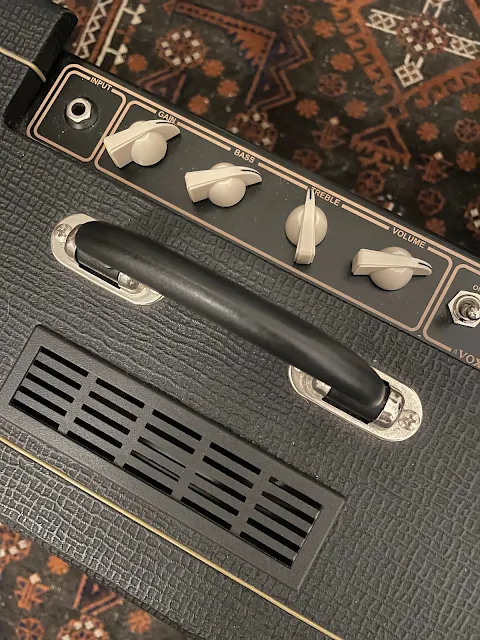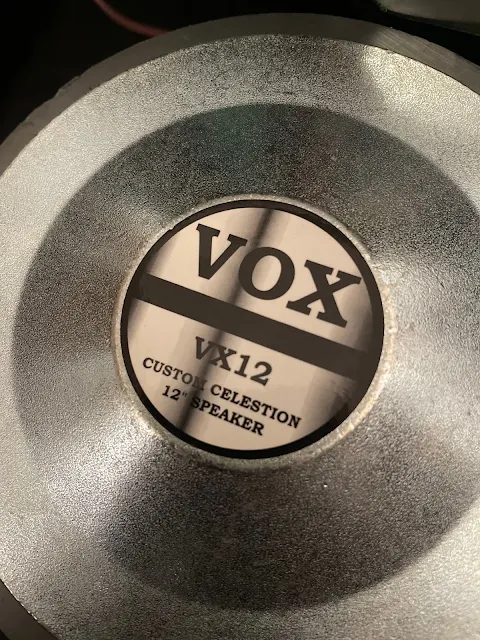I picked up a Vox AC4C1with a 12" speaker recently, as it was selling really cheap second-hand, and it looked like it was straight out of the box. I have a sneaking suspicion that the previous owner hated it - he seemed glad to be rid of it.
Note: comments below relate to the stock amp - no mods. I wrote this post just after buying the amp.
VOX AC4C1-12 GUITAR AMPLIFIER
How does it sound?
It sounds truly awful running at low levels - I think this is what has earned its bad reputation on several forums. However, this little amp sounds pretty damn good when you crank it. Turn the volume up, and set it on the edge of breakup (or further) with the gain, and the amp comes alive.
I was running the volume at full for a decent amount of time - I measured 110dbA at one metre on the leq setting on my meter (that's an average, not peak). I don't think the previous owner gave it much use, so I thought I should crank it to break the speaker in a bit, and it was a fun way to get to know the amp.
I think some people assumed that the AC4 would be good at low levels because of the low wattage, and the spiel from Vox refers to it as "Famous for its ability to achieve classic VOX tone at low volume levels" which should perhaps include the disclaimer, when compared to how loud a cranked AC30 is. If you want a small Vox amplifier that can sound good at low levels, buy a Pathfinder 15R or something along those lines.
VOX AC4C1-12 SPECS
- Gain, bass, treble and volume
- 2 x 12AX7, 1 x EL84 (solid state rectifier)
- 4-watt RMS into 16ohms
- Weighs 10.6 kilograms
- Vox VX12 12-inch speaker. Which is a Celestion Seventy 80 more on that below.
VOX AC4C1-12 MODS
Warning number 1. Valve amps contain lethal voltages. Don't go poking around in there if you are not sure of what you're doing, as you might just end up dead.
Warning number 2. Upgrading cheap valve amps can be an expensive exercise, with no financial return when you decide to sell.
The Infamous Bright Caps
OK, so if you have read anything about Vox AC4 mods, you’ll read a lot about bright caps. My view is that people buy the amp, decide they don't like it, and then try to mod their way out of it. I think these are the same people who run it at low levels and regret their purchase, then desperately try to fix it (a huge assumption on my part, but there it is).
The capacitors in question are C6, the 120pf cap across pins 3 and 2 on the gain pot, and C20, the 100pf cap across the same pins of the volume pot. If the description I just gave and the schematic don't mean anything to you, the small capacitors are similar to a treble bleed on a guitar volume pot - when the gain or volume is low, the caps let high frequencies through (bypassing the pot). The effect reduces as the pots are turned up.
C6 is present on the gain pot of a regular Vox Top Boost channel. As far as I'm aware, C20 on the volume pot is not used on any of the traditional lineup of Vox amps - in fact, the opposite occurs with the AC30, with a treble cut following the master volume in the power section.
The Cab
After bright caps, the next "fix"' for the AC4 is taking the back off the cabinet, or enlarging the bass port (which is tiny). I tried it - taking the back off did make a difference, but not as much as I was led to believe it would on the forums. It was a little more open-sounding - there's a surprise. Again, the biggest improvement that I can find is turning it up, to the point where the room starts to play a larger role in the sound that the amp is producing.
The Speaker
The VX12 is a rebranded Celestion Seventy 80, which is described by Celestion as detailed and crisply defined with a tightly controlled low-end and punchy aggressive upper mid-range. The top-end response is also subtly increased.
The Seventy-80 is a much-maligned speaker, with ample hate online compared to Vintage 30s and Greenbacks etc, although they do have their fans, and a fair number of people thinking they don't deserve the poor reputation they have.
If you have just bought this amp or have purchased one second-hand with very little use, the speaker will not be broken in. Get some solid hours on it at a decent level to loosen things up before deciding you need to replace the speaker (over 20 hours). It's not the high end that changes; it's the mids and lows that start to breathe - the balance will shift, which may help with one of the complaints about the sound of the amp.
Don't take my word for it, check this from Ignazio Vagnone from Jensen speakers. This advice is not specific to Jensens, according to Ignazio, all speakers, all brands need break in.
If you still don't like it after breaking it in and decide to try a different speaker, it's important to note that there's very little space between the output transformer and the speaker magnet - we're talking about 10mm... a lot of common speakers will not fit without moving the output transformer. There is room to do this, however, the leads connecting the transformer don't allow much movement, at least on mine anyway, I'm assuming others will be the same.
As a reference, the Seventy 80 magnet is 134 mm wide and the speaker is 119mm in depth.
The Output Transformer
The AC4 has an unbranded output transformer. Some say that upgrading to a Hammond or similar transformer will remove the fizz that can be heard at times.
Hammond 125BSE (rated 5 watt)
Hammond 125CSE (rated 8 watt)
The internet says the stock transformer has a 10k primary running the 16 ohm speaker (forum post, not an official Vox spec). Others have mentioned that an EL84 likes to run with 5k on the primary, as per their datasheet. I measured the stock output transformer and it came in at 7.4k @ 16ohms.
Valves
Like any amp, swapping valves may or may not make much difference. I think despite the stock valves just being labelled as CHINA, there's nothing inherently wrong with them. For me, if I'm swapping out or replacing valves, I buy NOS or vintage ones that test well and are reasonably priced. Why - cause I like reusing old things. I never spend more than the price of a new valve on an old one.
Most modern valves come from just a handful of remaining factories. Popping Mullard on a new valve and selling in a box with vintage style artwork is just marketing.
So what’s a stock AC4 good for?
I think it would make a great little recording amp, if you’re chasing the sound of a Vox working hard. Possibly OK for small gigs if you only have variations of one tone, with that tone being a juiced Vox.
Pairing with another larger AC for a stereo rig. Paired with my AC15 with a Alnico blue it sounds great. The larger AC lifted the smaller amp, and the AC4 was in no way detrimental to the AC15.
What is it bad at?
It does not sound good at low levels, the clean tones are especially bad..
How does it compare to the 10" AC4 model
The 12" version is noticeably better - do not buy the 10" AC4 unless you plan on plugging it into an extension cab. The 10" is really boxy sounding. They're tempting cause they're often going cheap and they look cool.
What mods have I done?
Note: all comments above relate to the un-modded AC4.
- replaced the stock speaker with a MSP vintage alnico speaker
- cut the C20 bright cap on the volume control
- swapped a pre-amp valve for something vintage I had lying around
- replaced the output transformer - details here






No comments:
Post a Comment